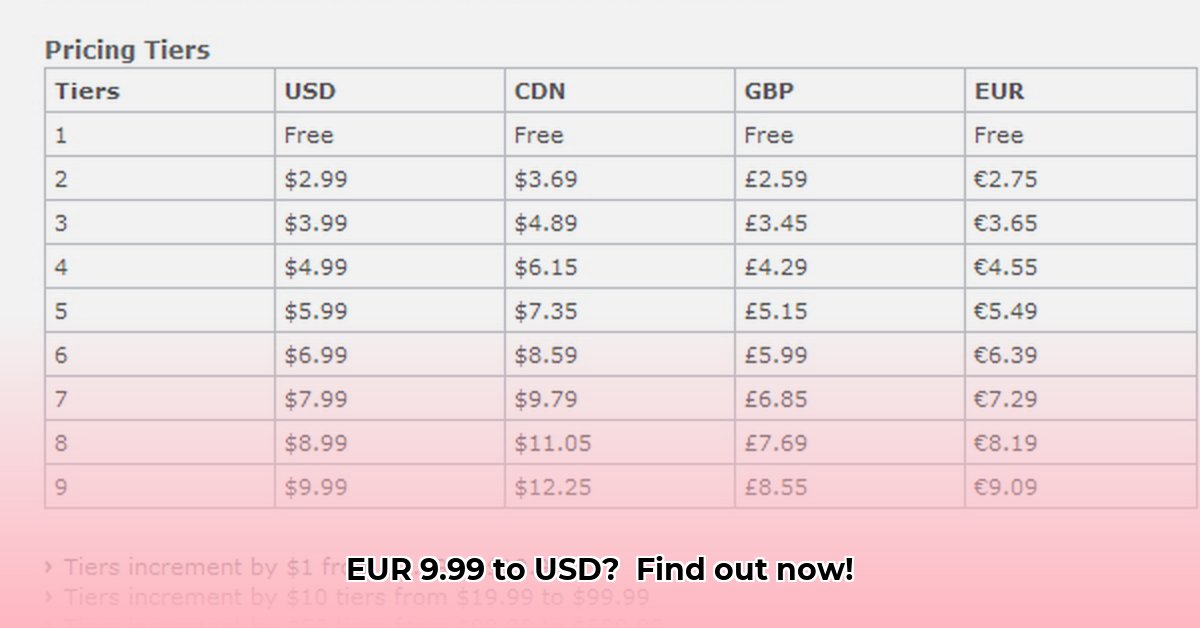
EUR 9.99 to USD: Today's Rate and What Drives It
Converting €9.99 to US dollars requires understanding the current exchange rate and the factors influencing its fluctuation. The exchange rate isn't static; it constantly changes, creating both opportunities and risks for businesses and individuals involved in international transactions. For more on global financial markets including crypto, see European Crypto Exchanges.
Today's Exchange Rate: A Quick Overview
As of today, €9.99 converts to approximately $10.48 - $10.49 USD. This slight variation reflects the dynamic nature of currency markets and the different methods used by financial institutions to calculate the mid-market rate. Minor discrepancies are common and typically inconsequential for small transactions.
Fluctuations in the EUR/USD Exchange Rate: Why the Variability?
The EUR/USD exchange rate is not fixed; it fluctuates constantly. Over the past week, €9.99 has ranged from approximately $10.28 to $10.49. Looking further back, monthly and yearly variations are even more significant. This instability stems from a complex interplay of economic and political factors.
Key Factors Influencing EUR/USD Exchange Rates
Several key factors influence the Euro's value relative to the US dollar. These factors act in concert, creating a dynamic and often unpredictable market:
- Economic indicators: Inflation rates in both the Eurozone and the US significantly impact the exchange rate. Higher inflation in one region typically weakens its currency. GDP growth, unemployment figures, and consumer confidence also play a role.
- Interest rate differentials: Differences in interest rates between the European Central Bank (ECB) and the Federal Reserve (Fed) influence investment flows and consequently, exchange rates. Higher interest rates generally attract investment, strengthening the currency.
- Geopolitical events: Global events, such as political instability, wars, or major international agreements, can significantly impact investor sentiment and lead to sharp exchange rate movements.
- Market sentiment: Broad market sentiment, reflecting overall investor optimism or pessimism, influences exchange rate fluctuations. Positive sentiment often leads to stronger currencies.
How do these factors impact individuals and businesses? Let's examine some key stakeholders:
| Stakeholder | Short-Term Impacts | Long-Term Impacts |
|---|---|---|
| International Businesses | Fluctuating costs and profits; increased need for hedging strategies | Requires robust strategies for long-term financial stability and risk management |
| Travelers | Trip costs vary with exchange rate changes. | Requires careful monitoring of exchange rates to minimize expenses. |
| Currency Traders (Forex Traders) | Short-term opportunities and significant risks. | Requires extensive knowledge of global economics and market analysis. |
Converting €9.99: Practical Implications
For individual transactions involving small amounts like €9.99, daily fluctuations typically have a negligible impact. However, for larger transactions, even small changes in the exchange rate can add up significantly.
The Broader Picture: Forecasting Exchange Rates
Predicting future exchange rates is challenging, even for experienced economists. While financial websites and news sources provide forecasts based on current trends and data, remember that these are estimations, not guarantees. The inherent uncertainty necessitates informed decision-making and, in many instances, hedging strategies.
How to Hedge Currency Risk for International Business Transactions
Fluctuating exchange rates pose significant challenges for businesses engaging in international trade. Effective risk management is critical to maintaining financial stability.
Understanding EUR/USD Volatility
The EUR/USD exchange rate is inherently volatile, influenced by numerous economic and political factors. Businesses need strategies to mitigate the potential negative financial impacts of these fluctuations.
Key Hedging Strategies
Various strategies exist to reduce currency risk. The optimal strategy depends on factors like transaction size, risk tolerance, and time horizon:
- Forward Contracts: Lock in a future exchange rate, providing certainty but eliminating the potential for a more favorable rate.
- Options Contracts: Give the right, but not the obligation, to buy or sell currency at a predetermined rate. Offers flexibility but incurs a premium cost.
- Currency Swaps: Exchange principal and interest payments in one currency for another. Suitable for long-term liabilities.
- Natural Hedging: Matching currency inflows and outflows organically to offset some risk. Less precise but often cost-effective.
Choosing the Right Strategy: A Personalized Approach
The best hedging strategy is specific to a business's needs:
- Transaction Size: Smaller transactions may not justify the cost of complex hedging strategies.
- Risk Tolerance: Risk-averse businesses prefer fixed-rate contracts like forwards, while those with higher risk tolerance may consider options.
- Time Horizon: Short-term needs suit forward contracts, while long-term exposure benefits from swaps or natural hedging.
A Simplified Example: Managing Risk with €9.99
Even a small transaction like €9.99 can benefit from risk management:
- Assess the risk: Determine your acceptable level of fluctuation.
- Choose a strategy: A simple forward contract might suffice for small amounts.
- Execute the hedge: Work with your bank or financial institution to implement the chosen strategy.
Key Takeaways:
- Currency risk is a critical concern for international businesses.
- Numerous hedging strategies offer various levels of risk mitigation.
- Strategy selection requires careful consideration of individual business needs and risk profiles.
- Effective currency risk management enhances financial stability and predictability. Understanding how to hedge currency risk is crucial for success in global markets.